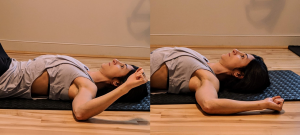Execution of a standing overhead barbell press may appear to be a simple movement, but technique is often difficult to nail down due to muscle imbalances and mobility issues. Teaching a personal training client to properly prepare for the movement, engage the core, and remain focused on form is no easy task.
An overhead press is the best overall exercise to hit the deltoids, especially the middle deltoid, as well as upper traps, but it also is plenty taxing on the core and stability muscles of the lower body.
Why a Barbell?
Working with barbells symbolizes serious strength gains for a reason: they are able to be heavily loaded and require a command of joint stability and core bracing that machines do not.
An Olympic bar usually weighs 45 pounds and is 7.2 ft long. The shorter, lighter versions are 6.5 ft long and 35 lbs. have traditionally been called “junior” barbells or women’s barbells. Both are 1 inch around the grip shaft, but 2 inches around the sleeve where the plates are loaded. This bar handles added weights up to 1000 lbs.
A “standard” barbell is only 1 inch in diameter all the way through to the sleeve, and is commonly seen in home gyms. It can only handly up to 200 loaded pounds.
Dumbbells (and kettlebells) require an even greater degree of joint stability to control, making them a poor choice for heavier lifts: the risk for injury is somewhat greater. I employ light to moderate dumbbell weights for a seated overhead press where my spine and core are supported by the seat and I can concentrate on stabilizing my shoulders.
When I want to go heavy, I pick up a barbell.
Ensuring Proper Shoulder Mobility
Throwing a barbell overhead is not a beginner activity. Still, even seasoned lifters have a problem with this movement due to lack of mobility in the shoulder joints (there are three: glenohumeral, acromioclavicular, and sternoclavicular!).
To determine if one has adequate mobility to safely press a barbell overhead, shoulder mobility should be properly assessed.
Flexion should be tested and be pretty close to 180 degrees (lying on the ground with arms by ears and back of hands touching grounds with straight elbows.

External rotation should be adequate at 90 degrees (arms abducted to 90 degrees, elbows bent to 90 degrees, back of hands flat on floor).

Arm lying flat on floor is adequate external rotation.
Finally, upward rotation should be ideal. This is the hardest to determine without removing someone’s top! You can do a full shoulder assessment and corrective program if the client seems to have a forward head, hyperkyphotic thoracic curvature and/or elevated shoulders. This most certainly can’t hurt!
Preparatory and Warm-Up Movements for Overhead Barbell Press
It’s always wise to warm-up the shoulders for any upper-body workout. You can employ a series of exercises for overall shoulder mobility, or if time is a factor, a good lower trap scaption or “Y” movement is great to activate the upward rotators and work in end-range flexion.
It’s also a great idea to activate the infraspinatus with a little external rotation movement. This position with the arm in 90 degrees flexion activates this rotator cuff muscle more (and minimizes synergistically dominant muscle recruitment) than any other position.
Performing the Overhead Barbell Press
For women who are fairly strong but have not used a barbell before, start with the women’s barbell if it’s available. If not, spot her on the bigger Olympic bar with added assistance throughout on the first set. If your women clients can overhead press 20lb dumbbells and have solid shoulder mobility, they should have no problem lifting the regular-sized Olympic bar.
This is not to say that your male clients will have a cake-walk time lifting a bar if they never have. If they aren’t used to pressing 20lb dumbbells overhead, please spot them on their first lift carefully.
-
- Approach the racked bar set to shoulder height
- Grip the bar overhand, slightly wider than shoulder-width (Grip distance can vary to wider than this, but work up to that as it is more stress on the shoulder)
- Unrack and bring the barbell to the upper chest
- Root the feet firmly into the ground, engage the quads and glutes, and brace the core, (or wear a sturdy weight belt)
- Take a deep breath in, then exhale while driving the bar in a straight line upwards until arms are straight and shoulders elevate slightly
- Hold in place for one second before controlling back down
- Inhale while bringing the bar back to the chest
Notes to consider
The back will extend slightly during the movement. A strong core will fire up and prevent hyperextension.
Keep the cervical spine straight and chin slightly tucked while the bar clears the face.
Don’t bend or bounce the knees. A push-press is a power move that involves a lower body drive force.
Wait until at least three sets of six are performed with solid form on an unloaded barbell before progressing to a heavier weight.
NFPT Publisher Michele G Rogers, MA, NFPT-CPT and EBFA Barefoot Training Specialist manages and coordinates educational blogs and social media content for NFPT, as well as NFPT exam development. She’s been a personal trainer and health coach for over 20 years fueled by a lifetime passion for all things health and fitness. Her mission is to raise kinesthetic awareness and nurture a mind-body connection, helping people achieve a higher state of health and wellness. After battling and conquering chronic back pain and becoming a parent, Michele aims her training approach to emphasize fluidity of movement, corrective exercise, and pain resolution. She holds a master’s degree in Applied Health Psychology from Northern Arizona University. Follow Michele on Instagram.

